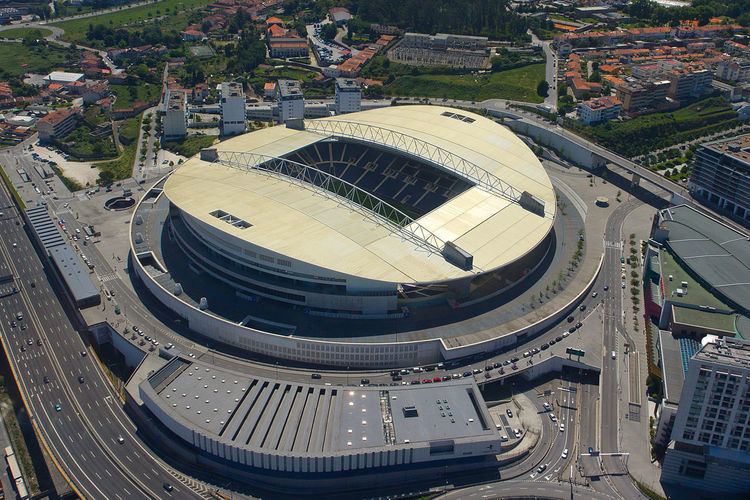Executive suites 96 Opened 16 November 2003 Architect Manuel Salgado | Capacity 50,035 | |
 | ||
Address Via Futebol Clube do Porto, 4350-415 Porto, Portugal Similar Estádio da Luz, Estádio José Alvalade, Estádio das Antas, FC Porto Museum, Estádio do Bessa Profiles | ||
Os segredos do est dio do drag o
The Estádio do Dragão ([(ɨ)ˈʃtadiu du dɾɐˈɣɐ̃w]; Dragon Stadium) is an all-seater football stadium located in Porto, Portugal, and the current home ground of Futebol Clube do Porto. It has a capacity of 52,000, making it the second largest football ground in Portugal.
Contents
- Os segredos do est dio do drag o
- Hino do fcp est dio do drag o fcp 2 x 1 slb 11 05 2013
- Construction and inauguration
- Naming
- Portugal national team
- Euro 2004
- Other uses
- Transportation
- References
Designed by Portuguese architect Manuel Salgado, the stadium was built to replace Porto's previous ground, the Estádio das Antas, and was inaugurated on 16 November 2003 with a friendly match against Barcelona, which set an attendance record of 52,000 spectators. A UEFA category four stadium, it hosted UEFA Euro 2004 matches, including the opening, and has held several other international club competition and national team matches. It has also served as a concert venue to international musical artists, such as Coldplay, Muse and The Rolling Stones.
Hino do fcp est dio do drag o fcp 2 x 1 slb 11 05 2013
Construction and inauguration
Construction works began in late 2001, and were complete in November 2003, some months after what was expected, since in February 2002, Porto mayor Rui Rio changed the estate distribution, criticizing the plan for including high-scale housing and shopping for the area. These actions forced the chairman of FC Porto, Jorge Nuno Pinto da Costa, to halt all building operations, which were only resumed after a consensus was reached.
Designed by Portuguese architect Manuel Salgado and built by Portuguese contractor Somague, it cost €97,755,318, of which €18,430,956 was subsidized by the government. To help underwrite costs, each stand carries one or two sponsor names: Super Bock (south), tmn (east), meo (west), and Coca-Cola (north stand). Away fans are placed in the left corner of the north stand, while home Ultra groups, Super Dragões and Colectivo Ultras 95, occupy the south stand and the north stand, respectively, like on the old stadium.
The stadium was inaugurated on November 16, 2003, with a match against FC Barcelona, which featured the debut of a 16-year-old Lionel Messi in the Catalan side. Porto won 2–0 with goals by Derlei and Hugo Almeida. Due to severe turf problems, however, Porto was forced to return and play in the old Estádio das Antas, until the turf was replanted by mid-February 2004.
Naming
The stadium's name is derived from the presence of a dragon on the club's crest, which is composed of an old stitched leather football under the city's coat of arms. It is also the nickname of the club's football team. Other alternatives were considered, such as keeping the old name, Estádio das Antas (officially, unlike the former stadium), or name after former player Pinga, former manager José Maria Pedroto, or president Pinto da Costa (holding office since 1982).
Portugal national team
The following national team matches were held in the stadium.
Euro 2004
Constructed to become one of the venues of the UEFA Euro 2004 tournament, it staged the inaugural match between hosts Portugal and eventual winners Greece, as well as three group stage, one quarterfinal, and one semifinal fixtures.
Other uses
The stadium further cemented its reputation as an all-round sports and entertainment venue when it hosted the Portuguese leg of The Rolling Stones 2006 world tour, and the 2009 Race of Champions South Europe finals. In 2012 it hosted the kick-off to Coldplay's Mylo Xyloto Tour 2nd European leg. On June 10, 2013, Muse performed at the stadium as part of their The 2nd Law Tour. Also, One Direction brought their Where We Are Tour (One Direction) to the stadium in July 2014.
Transportation
The stadium is served by its own metro station (Estádio do Dragão) along lines A, B, E and F, which link it to the city centre and international airport. It is also served by bus (routes 401, 700, 800, 801, 806 and 7M) and taxis.
